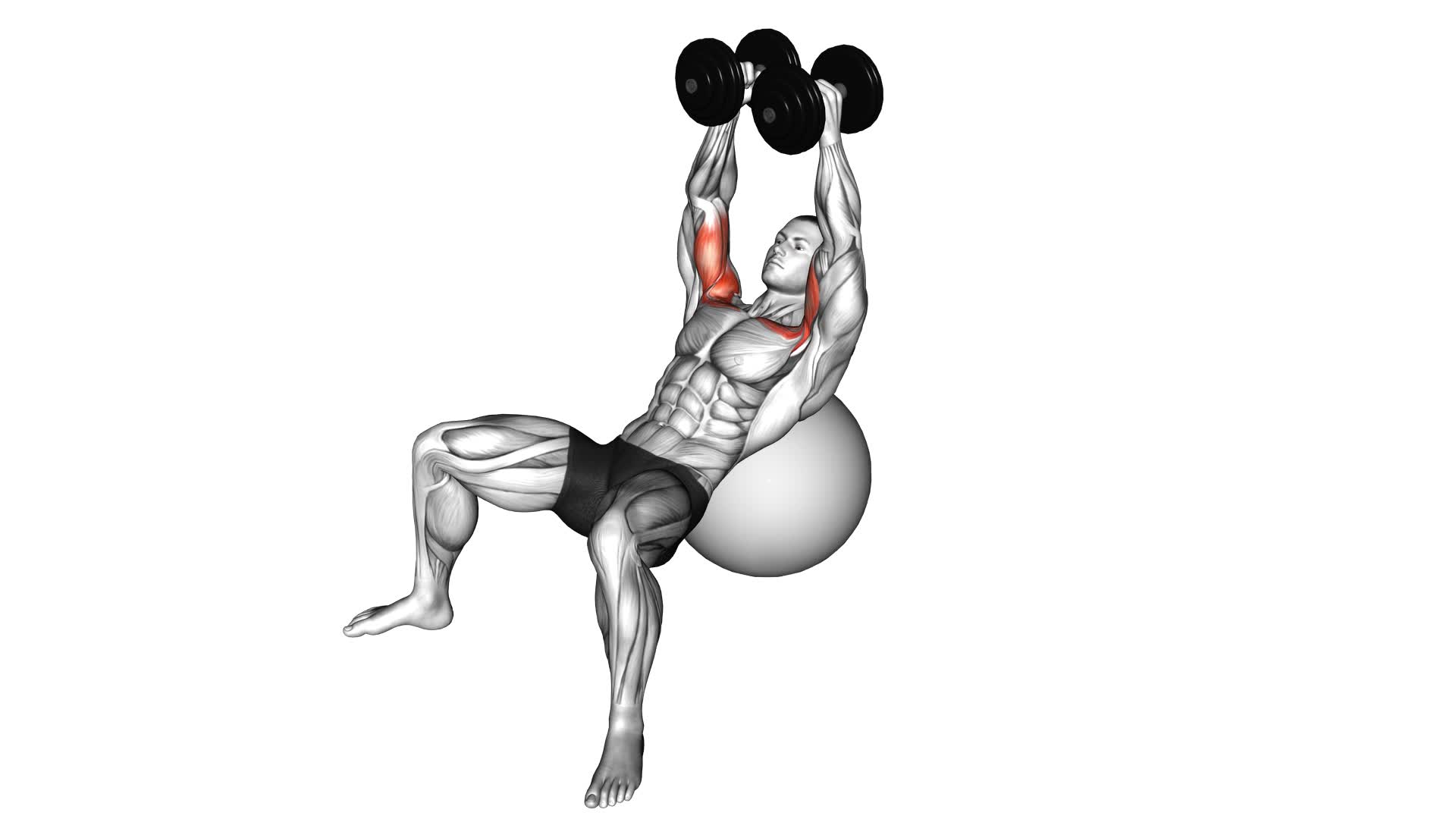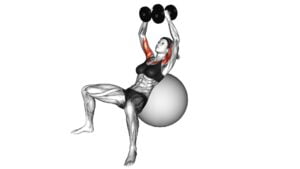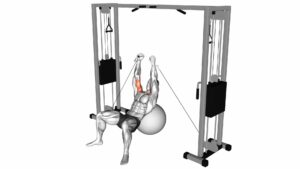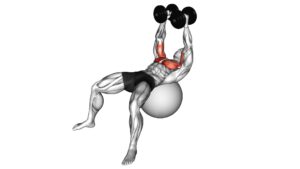Dumbbell Incline Fly on Exercise Ball – Video Exercise Guide & Tips

Looking to amp up your upper body workout? Check out the dumbbell incline fly on the exercise ball. This challenging exercise targets your chest and shoulders while also engaging your core.
Watch This Exercise Video
In this video exercise guide, you'll learn the proper form and technique, as well as helpful tips for maximizing your workout.
Grab your dumbbells and get ready to take your fitness routine to the next level. Let's get started!
Key Takeaways
- The dumbbell incline fly is a versatile exercise that targets different areas of the chest muscles.
- Proper form and technique are important to avoid shoulder strain and maintain body alignment.
- Engaging core muscles and maintaining a neutral spine can help prevent shoulder strain during the exercise.
- The equipment needed for the exercise includes dumbbells, an exercise ball or yoga ball, a bench or stability platform, and resistance bands as alternatives.
Benefits of the Dumbbell Incline Fly
There are three key benefits to incorporating the dumbbell incline fly into your workout routine.
Firstly, the dumbbell incline fly is a versatile exercise that allows for various variations. By adjusting the angle of the bench, you can target different areas of your chest muscles, such as the upper or lower chest. This variety in angles helps to engage and strengthen different muscle fibers, resulting in a well-rounded chest development.
Secondly, the dumbbell incline fly works multiple muscles in your upper body. Primarily, it targets the pectoralis major, which is the main muscle of your chest. Additionally, it engages the anterior deltoids, or front shoulder muscles, and the triceps brachii, located at the back of your upper arms. By working these muscles simultaneously, the dumbbell incline fly helps to improve upper body strength and stability.
Lastly, incorporating the dumbbell incline fly into your workout routine can help enhance your overall aesthetic appearance. By focusing on the chest muscles, this exercise can help create a more defined and sculpted chest. This can contribute to a more proportionate physique and boost your self-confidence.
Now that you understand the benefits, let's move on to discussing the proper form and technique for performing the dumbbell incline fly.
Proper Form and Technique
To perform the dumbbell incline fly on an exercise ball with proper form and technique, it's important to focus on body alignment and avoid shoulder strain.
Keep your back straight and core engaged throughout the exercise to maintain stability and prevent injury.
Additionally, be mindful of your shoulder position and avoid excessive strain by using a controlled and smooth motion.
Body Alignment During Exercise
Maintain proper body alignment during exercise to optimize form and technique. Proper body alignment provides numerous benefits during exercise, including improved stability, reduced risk of injury, and increased muscle activation.
When your body is aligned correctly, it allows for efficient movement and ensures that the targeted muscles are being properly engaged. To achieve proper body alignment, focus on a few key points.
Firstly, maintain a neutral spine by keeping your head, neck, and back in a straight line.
Secondly, engage your core muscles to support your spine and maintain stability.
Lastly, ensure that your shoulders are relaxed and pulled back, avoiding any hunching or rounding.
By maintaining proper body alignment, you can enhance the effectiveness of your workouts and minimize the risk of strain or injury.
Avoiding Shoulder Strain
To avoid shoulder strain and ensure proper form and technique, focus on engaging your core muscles and maintaining a neutral spine alignment during the Dumbbell Incline Fly on Exercise Ball. This won't only prevent shoulder injury but also improve shoulder stability. Here are three key tips to help you achieve this:
- Engage your core: By actively contracting your abdominal and back muscles, you provide a stable base for your shoulders to move from. This helps distribute the load evenly and reduces the risk of strain.
- Maintain a neutral spine: Keep your back in a straight position, avoiding any excessive arching or rounding. This helps align your shoulders properly and promotes optimal shoulder mechanics.
- Control your range of motion: Avoid overstretching or forcefully extending your arms during the exercise. Instead, focus on controlled movements within a comfortable range to protect your shoulders from excessive strain.
Equipment Needed for the Exercise
To perform the dumbbell incline fly on an exercise ball, you'll need a few essential pieces of equipment.
First, you'll need a set of dumbbells that are appropriate for your fitness level.
Additionally, you'll need an exercise ball that's the right size for your height.
Required Exercise Equipment
You will frequently need specific exercise equipment to perform the Dumbbell Incline Fly on an Exercise Ball. Here are the three essential items you'll need for this exercise:
- Exercise Ball: The exercise ball is a key piece of equipment for the Dumbbell Incline Fly. It provides stability and challenges your core muscles during the exercise. Make sure to choose a ball that's the appropriate size for your height.
- Dumbbells: Dumbbells are used to add resistance and target your chest muscles during the exercise. Select a weight that's challenging but still allows you to maintain proper form throughout the movement.
- Bench or Stability Platform: To perform the Dumbbell Incline Fly on an Exercise Ball, you'll need a bench or a stability platform to support your upper body. This will allow you to maintain the proper incline position while performing the exercise.
Essential Tools for Exercise
After acquiring the necessary exercise equipment, it's important to understand the essential tools needed for the Dumbbell Incline Fly on an Exercise Ball.
Resistance training, like the Dumbbell Incline Fly, offers numerous benefits such as increased muscle strength, improved bone density, and enhanced overall fitness.
To perform this exercise effectively, you'll need a few key pieces of equipment. First, you'll need a set of dumbbells. Choose a weight that challenges you but allows you to maintain proper form throughout the exercise.
Additionally, an exercise ball is crucial for stability and engaging your core muscles. Make sure the ball is the appropriate size for your height.
Finally, a sturdy and non-slip exercise mat is essential for providing a comfortable and safe surface for your workout.
Equipment for Effective Workout
To effectively perform the Dumbbell Incline Fly on an Exercise Ball, you'll need specific equipment. Here are three essential items you should have:
- Dumbbells: Choose a pair of dumbbells that are appropriate for your fitness level. The weight should be challenging but manageable. You can start with lighter dumbbells and gradually increase the weight as you get stronger.
- Exercise Ball: An exercise ball, also known as a stability ball, is necessary for this exercise. Make sure you choose a ball that's the right size for your height. When sitting on the ball, your knees should be at a 90-degree angle.
- Bench or Incline Board: To perform the dumbbell incline fly, you'll need a bench or an incline board. This will provide the necessary support and stability for your upper body during the exercise.
If you don't have access to these specific items, there are alternatives you can consider. For example, you can use resistance bands instead of dumbbells, a yoga ball instead of an exercise ball, and even a sturdy chair instead of a bench or incline board. Just make sure to adapt the exercise to your available equipment while maintaining proper form and safety.
Modifications and Progressions
To modify and progress the dumbbell incline fly on an exercise ball, try incorporating variations that challenge your muscles in different ways. One way to modify this exercise is by adjusting the weight of the dumbbells. If you find that the current weight is too challenging, you can decrease the weight to ensure proper form and prevent injury. On the other hand, if you feel that the exercise isn't challenging enough, you can increase the weight to provide a greater stimulus to your muscles.
Another modification you can make is by adjusting the angle of the incline. Start with a lower incline to make the exercise easier, and gradually increase the incline as you get stronger. This will increase the difficulty of the exercise and target your muscles from different angles.
Additionally, you can progress the dumbbell incline fly by incorporating unilateral movements. Instead of using both dumbbells simultaneously, try performing the exercise with one arm at a time. This will challenge your muscles and improve your stability and balance.
In conclusion, modifying and progressing the dumbbell incline fly on an exercise ball can be achieved by adjusting the weight, changing the incline angle, and incorporating unilateral movements. These variations will help you challenge your muscles in different ways and continue to make progress in your workouts.
Now, let's move on to the next section and discuss common mistakes to avoid.
Common Mistakes to Avoid
Avoid these common mistakes when performing the dumbbell incline fly on an exercise ball to ensure proper form and maximize results:
- Incorrect alignment:
One of the most common mistakes is improper alignment. Make sure your head, neck, and spine are in a straight line, and your feet are firmly planted on the ground. This will help maintain stability and prevent injury.
- Using too much weight:
Another mistake to avoid is using weights that are too heavy. Start with lighter weights and gradually increase as you build strength and confidence. Using excessive weight can compromise your form and increase the risk of strain or injury.
- Flaring your elbows:
When performing the dumbbell incline fly, it's important to keep your elbows slightly bent and close to your body. Avoid flaring your elbows out to the sides, as this can put unnecessary stress on your shoulder joints. Focus on maintaining control and keeping your movements smooth and controlled.
Tips for Maximizing Your Workout
To maximize your workout while performing the dumbbell incline fly on an exercise ball, focus on maintaining proper form and engaging your chest muscles throughout the entire exercise. By following these tips, you can effectively maximize your results and boost your workout intensity.
Firstly, it's crucial to maintain proper form during the exercise. This means keeping your back flat against the ball, your feet firmly planted on the ground, and your core engaged. Avoid arching your back or using momentum to lift the weights. By doing so, you ensure that your chest muscles are the primary focus of the exercise, leading to better results.
Secondly, make sure to engage your chest muscles throughout the entire movement. As you lower the weights, imagine squeezing your chest muscles together, creating tension in your chest. This will help you to target and activate the muscles more effectively, leading to increased muscle growth and strength.
Lastly, don't forget to challenge yourself by gradually increasing the weight or the number of repetitions. This will help to continually push your muscles and increase the intensity of your workout, ultimately maximizing your results.
Frequently Asked Questions
How Many Sets and Reps Should I Do for the Dumbbell Incline Fly Exercise?
For the dumbbell incline fly exercise, it's important to consider your fitness level and any shoulder injury prevention. Start with 2-3 sets of 8-12 reps, focusing on proper form and controlled movements.
If you're a beginner, you may want to start with lighter weights and gradually increase as you gain strength.
Can I Do the Dumbbell Incline Fly Exercise if I Have a Shoulder Injury?
If you have a shoulder injury, it's important to prioritize your rehabilitation and avoid exercises that could worsen the condition.
Consult with a healthcare professional for specific guidance on shoulder rehabilitation exercises.
In the meantime, you may be able to modify certain dumbbell exercises to be more shoulder-friendly.
Remember to always listen to your body and avoid any movements that cause pain or discomfort.
Is It Necessary to Use an Exercise Ball for the Dumbbell Incline Fly, or Can I Use a Bench Instead?
Using a bench for the dumbbell incline fly is a good alternative to using an exercise ball. It provides a stable surface for you to perform the exercise with proper form and control.
The bench allows you to focus on targeting your chest muscles without the added challenge of balancing on an exercise ball.
Make sure to choose a weight that challenges you but still allows you to maintain proper technique throughout the exercise.
Can I Do the Dumbbell Incline Fly Exercise at Home Without Any Equipment?
Yes, you can definitely do the dumbbell incline fly exercise at home without any equipment. There are variations of the exercise that you can try, such as performing it on a flat surface or using resistance bands instead of dumbbells.
Additionally, there are alternative exercises that target similar muscle groups, such as push-ups or chest presses. These exercises can help you achieve similar results without the need for equipment or a gym.
How Long Should I Rest Between Sets When Performing the Dumbbell Incline Fly Exercise?
When performing the dumbbell incline fly exercise, it's important to give yourself enough rest between sets to allow your muscles to recover.
The rest duration can vary depending on your fitness level and goals. Generally, a rest period of 1-2 minutes is recommended.
However, if you're aiming for more strength and endurance, you may opt for shorter rest periods of 30-60 seconds.
Remember to listen to your body and adjust the rest duration as needed.
Conclusion
In conclusion, the dumbbell incline fly is a highly effective exercise for targeting the chest muscles. By maintaining proper form and using the appropriate equipment, you can maximize the benefits of this exercise.
It's important to avoid common mistakes and make modifications or progressions as needed. By following these tips, you can ensure a successful and efficient workout.

Author
Years ago, the spark of my life’s passion ignited in my mind the moment I stepped into the local gym for the first time. The inaugural bead of perspiration, the initial endeavor, the very first surge of endorphins, and a sense of pride that washed over me post-workout marked the beginning of my deep-seated interest in strength sports, fitness, and sports nutrition. This very curiosity blossomed rapidly into a profound fascination, propelling me to earn a Master’s degree in Physical Education from the Academy of Physical Education in Krakow, followed by a Sports Manager diploma from the Jagiellonian University. My journey of growth led me to gain more specialized qualifications, such as being a certified personal trainer with a focus on sports dietetics, a lifeguard, and an instructor for wellness and corrective gymnastics. Theoretical knowledge paired seamlessly with practical experience, reinforcing my belief that the transformation of individuals under my guidance was also a reflection of my personal growth. This belief holds true even today. Each day, I strive to push the boundaries and explore new realms. These realms gently elevate me to greater heights. The unique combination of passion for my field and the continuous quest for growth fuels my drive to break new ground.







